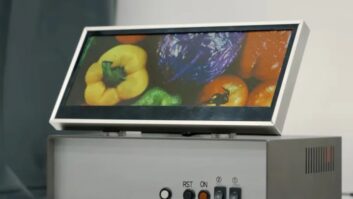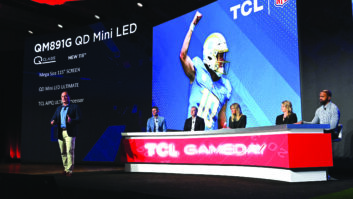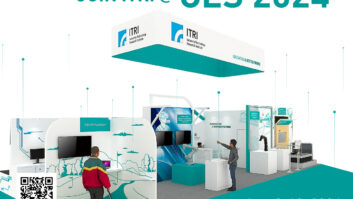LAS VEGAS – The 2014 International CES should serve as an important milestone in the launch of the next evolutionary step in consumer television technology.
After the introduction last year of a promising new technology in large-screen OLED displays and a full introductory year for Ultra HD televisions, 2014 should mark a significant momentum push toward the mass market.
At the same time, this year’s show will give attendees a first-hand look at one of the holy grails of both these systems combined with the unveiling of a very high-end Ultra HD OLED TV model from LG Electronics (77EC9700). The 77-inch curved-screen unit is promised to deliver some of richest colors and deepest black levels available to match the screen’s 3,820 by 2,160 resolution. But it won’t come cheap, with some industry observers speculating a retail launch price of around $20,000. (LG did not issue official pricing as this went to press.)
For obvious reasons, U.S. OLED TV sales are forecast to be expectedly scant after one year in the market this summer. But set makers said sales of, and more importantly, the interest generated by, the limited quantities of the first OLED models have been very promising.
Manufacturers have made great advances in OLED mass-production capability, but as with most radical new technologies, some obstacles still need to be overcome before very high volumes and dramatically lower prices are possible.
In addition, early forecasts from Consumer Electronics Association (CEA) market research show U.S. sales of Ultra HD sets (mostly LCD) in 2014 are expected to climb to 450,000 units in 2014, while DisplaySearch projections for North America peg 2014 Ultra HD sales at 550,000.
As a result, manufacturers are continuing to evolve LED LCD TV technology to fill the void and address the top of that more mainstream technology class.
Manufacturers including Sony, LG and Samsung are using the curved-screen approach seen in early OLED TVs and applying it to large-screen LED LCD TVs.
In the case of LG and Samsung, the first curved-screen Ultra HD LCD TVs will emerge at the show.
In fact, both Samsung and LG announced two weeks ago that they will each offer 105-inch curved-screen Ultra HD LCD TVs. In LG’s case, the new UB9 series set will offer a curved ultra-widescreen 21:9 aspect ratio, an onboard 150-watt 7.2-channel surround system, and new WebOS smart-TV platform with advanced graphics and search and recommendation capabilities.
Samsung has its own OLED TV plans, but it is also addressing the curved-screen LED LCD TV space with a 105-inch 21:9 widescreen model, and a flagship 16:9 curved-screen Ultra HD LCD TV line in the U9000 series, including the 55-, 65- and 78-inch screen sizes.
Samsung is also expanding its flat-screen Ultra HD LED LCD TV offerings to include the 50-, 55-, 60- (tentatively), 65- and 75-inch screen sizes, and is adding a 110-inch Ultra HD screen size to the easel-frame-style series used for last year’s 85-inch S9 model.
Sharp, meanwhile, is taking a potentially disruptive step by introducing the first Aquos LED LCD TV sets employing what it calls QuattronPlus technology. The technology uses a FullHD quad-pixel Quattron panel and then splits in processing the vertical pixels to 2,160 while processing horizontal RGBY resolution to expand the subpixel field from 3 million to more than 6 million. The result is a class of TV picture quality that fits above conventional FullHD 1080p and below Ultra HD.
Sharp said it will also continue to expand its 4K Ultra HD TV line later in 2014 to three models, but is stressing here the new QuattronPlus class to offer consumers a great picture at sub-Ultra HD price points.
In fact, Sharp’s marketing team insisted that most people won’t be able to discern a difference in quality on the sales floor between a QuattronPlus panel and an Ultra HD panel from its value-oriented brand competitors that have only limited up-scaling capability.
Meanwhile, companies including Toshiba, Seiki Digital, TCL and Hisense are all planning to expand their Ultra HD TV lines this year, even as a few newcomers jump on board.
On Corp. is unveiling its first RCA-branded UHD TV line with three models: the 55-inch SLD55A65RXQ, the 65-inch SLD65A70RXQ and the 84-inch SLD84A65RXQ.
All three will include smart-TV functionality based on the Android TV platform delivering an integrated onscreen interface with access to apps and online content, a Google Chrome web browser, Google’s Prime Time Guide for browsing channels while streaming or watching live TV, and support for the Wi-Fi-based Miracast standard for content sharing.
Toshiba is upping its Ultra HD offerings in 2014 with five models in four screen sizes across three series.
The L8400 Ultra HD LCD TV series features the 50- and 58-inch screen sizes with LED edge lighting, a CQ4K (quad- plus dual-core) picture engine, new HDMI (a.k.a. 2.0) input, HDCP 2.2 content protection, HEVC H.265 compression decoding, Labyrinth speaker system with DTS Premium Surround Suite and a new Cloud Portal TV system that adds basic-level voice control commands.
All Toshiba 2014 Ultra HD TVs will have the DirecTV RVU system, which Ramirez sees as the company’s eventual native 4K content solution along with eventual 4K streaming content from Netflix delivered via the Cloud Portal System.
Toshiba’s L9400 series stands as the brand’s premium series, including the 58- and 65-inch screen sizes, and a new Radiance 4K panel using Toshiba’s own Ultra HD full-array LED backlit panel yielding double the brightness of conventional backlit LED systems.
Toshiba will continue to offer an 84-inch Ultra HD in the 84L9450, featuring the same chassis as the L9400 series but using LED edge lighting.
Seiki Digital is repositioning itself for Ultra HD by introducing a new Seiki Pro brand to distinguish its 4K Ultra HD offerings. The company is launching the line with new Ultra HD LCD models in the 58-, 65- and 85-inch screen sizes. Among other things, the new sets will include an improved up-scaling system to present FullHD 1080p images on the Ultra HD screens, and HDMI inputs capable of receiving 60Hz Ultra HD content.
Seiki will be showing a new 4K up-scaling HDMI cable solution to show how good regular HD content can look on a Seiki Pro Ultra HD screen. The company said the solution employs a video-processing chip from Marseille packaged into the HDMI cable.













